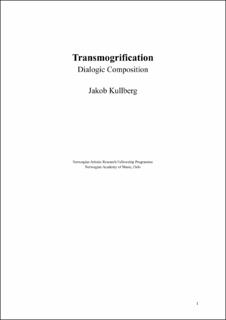| dc.contributor.author | Kullberg, Jakob | |
| dc.date.accessioned | 2022-05-03T13:00:22Z | |
| dc.date.available | 2022-05-03T13:00:22Z | |
| dc.date.issued | 2021 | |
| dc.identifier.uri | https://hdl.handle.net/11250/2993966 | |
| dc.description | Transmogrification -
This project deals with the hierarchy between composer and performer, and how these established roles can become more equal and more creative on both sides of the fence.
As part of his project Kullberg works with four Nordic composers namely Per Nørgård, Kaija Saariaho, Henrik Hellstenius and Bent Sørensen. For each composer the project will be divided in two types of processes. -
1) Transmogrification: to change in appearance or form, especially strangely or grotesquely -
As a preparatory process each of these four composers have given Kullberg assignments that resemble transcriptions in nature, albeit rather impossible or at least less than obvious suggestions for transcription. Impossible in the sense that the assigned tasks cannot be carried out simply by redistributing the musical components in a new way, or by doubling or omitting existing components. The idea is that each assignment from the composers forces Kullberg into a gray area that combines simple re-arrangement with actual composition. Hence the idea to use the word transmogrification instead of transcription. It is of key importance to the idea behind transmogrification, that Kullberg strive to be creative inside the framework of each composition and that he attempts to stay inside the style of a given composer. The point with this process is to get deeper into each composer’s music and to start working with their musical material in a more creative way. The idea stems from the experience of making such a creative transcription of Per Nørgård’s music in close collaboration with the composer.
2) Dialogical Composition -
The secondary process is the collaboration on the composition of new works by each of the four composers. Here the idea is to attempt to meet somewhere in the middle and with each composer try to establish ways with which Kullberg creative potential can be utilised whilst still staying within each composer’s musical world. | en_US |
| dc.description.abstract | Contents:
Introduction. - Adaptation. - Why make adaptations? - Fidelity in Adaptation. - The Emergence of Werktreue. - Canonisation of the Work. - Priority. - Dialogue. - Introducing Bakhtin and Dialogism. - Heteroglossia. - Polyphony 13. - The Grotesque Body. - Transmogrification. - Prerequisite to Transmogrification – a Method Into the Composer’s Language. - Defining Transmogrification as a Method and a Process – Not an Outcome. - The work concept in the commercial world. - Locating Spaces of Creativity. - Working Within a Level Hierarchy. - The Apprentice – the Closing of the Work. - From Performer to (Co-)Composer. - Interpretation. - Hans Zender: Schubert’s Winterreise. - Henrik Hellstenius – Schumann’s Dichterliebe. - Eivind Buene – Song Adaptations. - Eivind Buene: Johannes Brahms Klarinetten Trio. - Dialogic Collaborations. - Henrik Hellstenius – Rift for string trio. - Reflection on Hellstenius’ Rift. - Instrumental Parts. - Nørgård’s 1st Cello Concerto, ‘Between’. - Three Nocturnal Movements & Remembering Child. - Dialogue with Saariaho. - Cadenza for Saariaho’s Notes on Light. - Cadenza for Nørgård’s ‘Remembering Child’. - Bent Sørensen – Nocturnal Improvisation. - Adaptation process. - Dialogic reflection on Nocturnal Improvisation. - Per Nørgård – Nocturnal Cadenza. - Process – Immersion Through Listening. - Nocturnal Improvisation vs. Nocturnal Cadenza. - Decanonisation. - A Foucauldian look at Nørgård. - Dialogue. - Nørgård’s Grotesque Body. - Conclusion - The Grotesque Cellist. - Dialogue. - Transmogrification. - Transcendence. - Bibliography | en_US |
| dc.language.iso | eng | en_US |
| dc.title | Transmogrification. Dialogic composition | en_US |
| dc.type | Research report | en_US |
| dc.subject.nsi | VDP::Humaniora: 000::Musikkvitenskap: 110::Annen musikkvitenskap: 119 | en_US |
| dc.source.pagenumber | 62 s. | en_US |
| dc.relation.project | The Norwegian Artistic Research Programme - The Norwegian Academy of Music - (2013–2022) | en_US |
